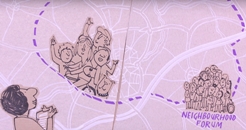 Community-Led Development
Community-Led Development
A previous blog took a look at self-build housing and the advantages it brings. I thought I would follow this up with a look at community involvement in local planning which can then lead to self-build schemes as well as neighbourhood improvement.
Locality have produced a guide for community groups considering involvement in neighbourhood planning. Neighbourhood plans can bring many benefits, including creating investor and business confidence, ensuring development is sustainable and gaining local support for growth. However, community groups can go further than just plans - community-led development can be a means to achieving these benefits and they can also address land and development viability problems.
Community organisations can operate on a different business basis to private sector developers, helping to make certain kinds of development deliverable, even where market conditions are challenging.
Community-led housing can focus specifically on need, providing housing that private builders are not providing in sufficient numbers. A small community-led housing scheme could be entirely comprised of affordable or smaller accommodation. This could include specialised forms of housing, such as housing suitable for the elderly or for people of limited mobility. Thus, community-led schemes can help to create a more balanced mix of housing in a neighbourhood area – a mix that neighbourhood plan policies would not achieve alone.
Community-led development could provide other facilities too. For example, a development scheme could include more green or urban open space than could be required by neighbourhood plan policies. Such space could be designed to support play or to accommodate events, markets or other social and economic activities.
Where a community organisation owns the land, any increase in value can be retained in the development. This can help to achieve more affordable accommodation, or larger and better quality accommodation at a given price level. Retaining land value increases for community benefit could be a reason for using a Community Right to Build Order to gain planning permission.
Community-led development can incorporate very high standards of architectural and urban design. Good design makes a real difference to quality of life, social inclusion and sustainability. Very high quality community-led development can help to achieve a range of community aspirations and aims (social, economic and environmental), and this can impact not just on the development itself, but also on the wider area.
Building performance and other aspects of sustainable construction can be incorporated into community-led development. Whilst the Building Regulations require certain standards, buildings could be designed to achieve much higher standards, for example in terms of insulation qualities and energy use. This is beneficial not just in terms of environmental sustainability, but also in creating accommodation with low running costs, delivering long-term social and economic benefit.
Community-led development is a means of taking control of the design process, construction and then subsequent management of housing. It can enable more creative approaches. For example, community-led housing could be a means to enabling and delivering self-build housing. This could be based on individual housing designs, or designing a small estate. This can allow families to get onto the housing ladder, where normally they would have no means of saving a deposit.
Community-led development is not just about housing. Indeed, considering housing in isolation will limit the chances of realising an area’s potential. The key challenge is in attracting investment and enabling economic restructuring. In many areas, the need may be more about attracting employment opportunities or community facilities. A community-led approach may be used to provide all kinds of development, including enterprise space and community energy generation.
Here's a 2 minute video on Neighbourhood Planning:
The Locality guide can be downloaded from here.
Want to do something about local housing, local facilities, local workplaces? Why not investigate community-led development?
Retweet about this article:
Geoff Knott, 11/10/2017